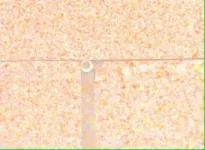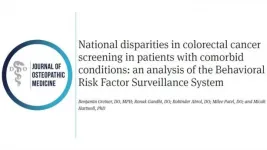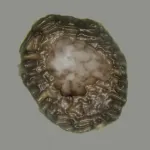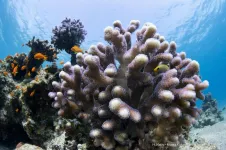(Press-News.org) ALBUQUERQUE, N.M. -- Sometime between 50,000 and 70,000 years ago, prehistoric humans took their first steps into Sahul, an ancient landmass made up of modern Australia, New Guinea and Tasmania. But nobody knows which way they went after that.
"One of the really big unanswered questions of prehistory is how Australia was populated in the distant past. Scholars have debated it for at least 150 years," said Sandia National Laboratories archaeologist and remote sensing scientist Devin White.
Now, an international team of scientists using a Sandia supercomputer in the largest reconstruction ever attempted of prehistoric travel has mapped the probable "superhighways" that led to the first peopling of Australia. Their results were published April 29 in Nature Human Behaviour.
Their methods could help organizations like the United Nations and the Federal Emergency Management Agency forecast modern day human migration resulting from climate change or sudden humanitarian crises, while the new maps could inform the search for undiscovered archaeological sites. The research team believes it also might be possible to apply their approach to other areas of the world, further illuminating the human story since the first migrations out of Africa about 120,000 years ago.
Powered by 125 billion simulations run on a supercomputer typically used to develop autonomous systems and machine learning technologies, the team's research is the first high-resolution computational analysis of human migration at a continental scale, dividing the entire supercontinent into pixels 1,640 feet (500 meters) across.
"It is the largest and most complex project of its kind that I'd ever been asked to take on," said White, who wrote the primary algorithm used, called "From Everywhere to Everywhere," and overhauled it to program the way-finders. For more than 15 years, White has used geospatial analysis, remote sensing and high-performance computing to study human transportation networks.
Archaeologist and computational social scientist Stefani Crabtree, a fellow at the Santa Fe Institute in Santa Fe, New Mexico, and professor at Utah State University in Logan led the study.
"We decided it would be really interesting to look at this question of human migration because the ways that we conceptualize a landscape should be relatively steady for a hiker in the 21st century and a person who was way-finding into a new region 70,000 years ago," Crabtree said. "If it's a new landscape and we don't have a map, we're going to want to know how to move efficiently throughout a space, where to find water, and where to camp -- and we'll orient ourselves based on high points around the lands."
Researchers packed a virtual 25-year-old woman with 22 pounds (10 kilograms) of tools and water and sent her on billions of walks across the continent as it would have looked 50,000 years ago. Her task: find the paths that require the fewest calories to traverse without straying too far from reliable sources of water or from highly visible landscape features like large rock outcrops. The team found that the simulations returned to certain paths again and again, which the researchers dubbed "superhighways," that line up well with the earliest known archaeological sites on the continent.
Researchers affiliated with the Australian Research Council Centre of Excellence for Australian Biodiversity and Heritage (CABAH) also contributed to the project and explained the strong connection between Aboriginal communities, the landscape they have traveled across for millennia and a timeless realm known as the Dreaming.
"Australia's not only the driest, but also the flattest populated continent on Earth," said Sean Ulm, the center's deputy director and a distinguished professor of archaeology at Queensland, Australia-based James Cook University. "Our research shows that prominent landscape features and water sources were critical for people to navigate and survive on the continent. In many Aboriginal societies, landscape features are believed to have been created by ancestral beings during the Dreaming. Every ridgeline, hill, river, beach and water source is named, storied and inscribed into the very fabric of societies, emphasising the intimate relationship between people and place. The landscape is literally woven into peoples' lives and their histories. It seems that these relationships between people and country probably date back to the earliest peopling of the continent."
INFORMATION:
Sandia National Laboratories is a multimission laboratory operated by National Technology and Engineering Solutions of Sandia LLC, a wholly owned subsidiary of Honeywell International Inc., for the U.S. Department of Energy's National Nuclear Security Administration. Sandia Labs has major research and development responsibilities in nuclear deterrence, global security, defense, energy technologies and economic competitiveness, with main facilities in Albuquerque, New Mexico, and Livermore, California.
Palo Alto, CA--New work from a Stanford University-led team of researchers including Carnegie's Arthur Grossman and Tingting Xiang unravels a longstanding mystery about the relationship between form and function in the genetic material of a diverse group of algae called dinoflagellates.
Their findings, published in Nature Genetics, have implications for understanding genomic organizational principles of all organisms.
Dinoflagellates include more than 2,000 species of marine and freshwater plankton, many of which are photosynthetic, and some of which also ingest other organisms ...
MADISON -- From radio to television to the internet, telecommunications transmissions are simply information carried on light waves and converted to electrical signals.
Silicon-based fiber optics are currently the best structures for high-speed, long distance transmissions, but graphene -- an all-carbon, ultra-thin and adaptable material -- could improve performance even more.
In a study published April 16 in ACS Photonics, University of Wisconsin-Madison researchers fabricated graphene into the smallest ribbon structures to date using a method that makes scaling-up simple. In tests with these tiny ribbons, ...
SEATTLE--A new study of hospital deaths in the United States, published today in JAMA Network Open, is the most comprehensive look yet at changes in hospital mortality during the pandemic. Researchers analyzed data on more than 20,000 patients admitted to hospitals for COVID-19, over nine full months, from March to November of 2020. They found that rates of in-hospital mortality among COVID patients fell 38% between March and May, but there was little further decline through November 2020.
The researchers aimed to uncover the most likely cause of the ...
People have become accustomed to having their temperature checked during the pandemic because fever is a key indicator of COVID-19.
A new commentary by Washington State University College of Nursing Associate Professor Catherine Van Son and Clinical Assistant Professor Deborah Eti proposes that taking a temperature is a less useful indicator of infection in older adults and that a pulse oximeter be used instead.
The paper, published in Frontiers in Medicine, said baseline temperatures are lower in older adults. A lower baseline temperature means a fever may ...
Buildings - The mirage effect
A team of researchers at Oak Ridge National Laboratory has developed a method to detect and measure air leaking from a building's walls and roof that is quicker, cheaper and less disruptive to occupants.
Current air leak detection options, such as using a blower door and smoke or infrared thermography, are costly and invasive. ORNL's method is conducted from outside, using an imaging technique to visualize the flow of air leaks and calculate the volumetric flow of air based on the refraction effects imaged by cameras.
"Similar to a mirage over a black top road in the middle of summer, which looks fuzzy because ...
BURLINGTON, VT -- In the aftermath of George Floyd's 2020 murder by former police officer Derek Chauvin, many families may find themselves actively engaging in--or uncomfortably fumbling around--discussions about race. For white parents looking to clearly communicate antiracist ideologies with their preadolescent children, a new study offers some insight.
"There's a difference between saying race "shouldn't" matter and race "doesn't" matter," explains Jamie Abaied, professor of developmental psychology at the University of Vermont and lead author of the study, ...
CHICAGO--May 3, 2021-- Patients with one or more health conditions are more likely to be screened for colorectal cancer than those without comorbidities, according to new research in the Journal of Osteopathic Medicine. However, patients with five or more health conditions are also less likely to be screened than patients with two to four health conditions.
Colorectal cancer is the second leading cause of cancer death in the U.S. resulting in more than 53,000 deaths each year. Regular colorectal screenings, whether colonoscopy or at-home stool test, ...
Chestnut Hill, MA (5/3/2021) -- The billion-year-old fossil of an organism, exquisitely preserved in the Scottish Highlands, reveals features of multicellularity nearly 400 million years before the biological trait emerged in the first animals, according to a new report in the journal Current Biology by an international team of researchers, including Boston College paleobotanist Paul K. Strother.
The discovery could be the "missing link" in the evolution of animals, according to the team, which included scientists from the U.S., United Kingdom, and Australia. The microfossil, discovered at Loch Torridon, contains two distinct cell types and could be the earliest example of complex multicellularity ...
ITHACA, N.Y. - A new Cornell University-led study examines how temperature affects fishing behavior and catches among inland fisher households in Cambodia, with important implications for understanding climate change.
The research, which used household surveys, temperature data and statistical models, revealed that when temperatures rise, people fish less often. At the same time, the study's authors indirectly found that stocks of fish and other aquatic foods also rise with temperatures, leading to slightly larger catches each time peopled fished. Without careful analysis, it would appear that overall fish catches appear unchanged annually, when in fact, more nuanced dynamics are at play.
The study highlights why it's necessary when studying changing environmental ...
Researchers at the University of Haifa, the Weizmann Institute and the Centre for Genomic Regulation (CRG) have built the first atlas of all of the different types of cells in Stylophora pistillata, a reef-building stony coral native to the Indo-Pacific oceans. Published today in the journal Cell, the study is the first to detect the presence of specialized immune cells in corals.
The findings provide new insights into the molecular biology and evolution of corals and will aid present and future conservation efforts to protect coral reef ecosystems threatened by rising temperatures and ocean acidification.
The map reveals that Stylophora pistillata has 40 different cell types over the three main stages ...



